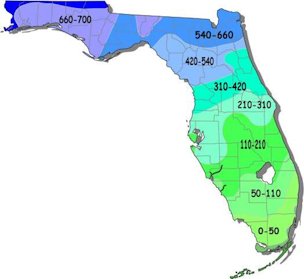Bunch Grape Varieties From the Horticultural Sciences Department, Florida Cooperative Extension Service Institute of Food and Agricultural Sciences, University of Florida There are only 7 varieties currently recommended that have Pierce's disease resistance to do well in Florida.
The University of Florida’s Agricultural Research Center at Leesburg and Apopka has had a breeding program for bunch grapes, resulting in the development of several bunch grape varieties. Resistance to Pierce’s disease has been the major selection criterion. The principal cause of poor results with bunch grapes in Florida is the prevalence of fungal diseases during hot humid growing conditions during the summer. There are only seven varieties currently recommended that have Pierce’s disease resistance to do well in Florida. All the varieties are self-fertile, so will bear full crops without another variety as pollenizer. 'Conquistador'z, 'Orlando Seedless', 'Black Spanish' and 'Stover' (recommended for Central Florida) require grafting on 'Tampa' or 'Dog Ridge' rootstocks for satisfactory growth and yields. The other varieties do not require grafting except in areas where the soil pH normally exceeds 7.0. 'Dog Ridge' is the best rootstock to graft them on under alkaline soil conditions. ‘Liberty’, formerly recommended, has given problems with Pierce’s disease and uneven ripening of berries on the bunch. ‘Roucaneuf ’, also formerly recommended, has lacked fruit quality in comparison to the recommended bunch grapes. ‘Black Spanish’ is resistant to Pierce’s disease, although it produces berries with a low sugar:acid ratio. Although ‘Orlando Seedless’ and ‘Norris’ are resistant to Pierce’s disease, they both can incur berry shattering and are very susceptible to anthracnose. Cultivar Release Bulletins Blanc Du Bois, University of Florida, Agricultural Experiment Stations, Gainsville FL pdf Blue Lake, University of Florida, Agricultural Experiment Stations, Gainsville FL pdf Conquistador, University of Florida, Agricultural Experiment Stations, Gainsville FL pdf Daytona, University of Florida, MREC/IFAS pdf Florilush, University of Florida, MREC/IFAS pdf Lake Emerald, University of Florida, Agricultural Experiment Stations, Gainsville FL pdf Liberty, University of Florida, Agricultural Experiment Stations, Gainsville FL pdf Norris, University of Florida, MREC/IFAS pdf Orlando, University of Florida, MREC/IFAS pdf Stover, University of Florida MREC/IFAS pdf Suwannee, University of Florida, MREC/IFAS pdf Tampa, University of Florida, MREC/IFAS pdf  Fig. 1  The University of Florida Institute of Food and Agricultural Science (UF-IFAS) tabulates chill hours (as opposed to average minimum temperature) in more detail for Florida and their map can be used to identify the expected range of chill hours for areas in Florida. Be sure to match your plants by Hardiness Zone and by chill hours if you live in Florida! Also Check the Zone Maps Back to Bunch Grape Page |
||||||||||||||||||||||||||||||||||||||||||||||||||||||||||||||||||||||||||||||||||||||||||||||||||||
| Bibliography Andersen, Peter C. "The Bunch Grape." Horticultural Sciences Dept., UF/IFAS Extension, HS-17A, Original pub. Aug. 2001, Revised Apr. 2014, and May 2017, Reviewed June 2020, AskIFAS, edis.ifas.ufl.edu/mg105. Accessed 17 Sept. 2018, 28 Sept. 2020. Illustration Fig. 1 "Florida Chill Hours Map." ifas.ufl.edu. Accessed 12 Apr. 2014. Published Feb. 2013 LR. Last update 28 Sept. 2020 LR |
||||||||||||||||||||||||||||||||||||||||||||||||||||||||||||||||||||||||||||||||||||||||||||||||||||